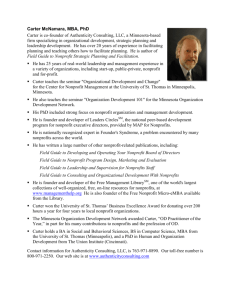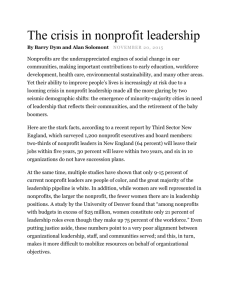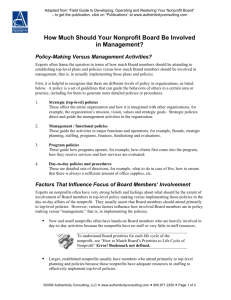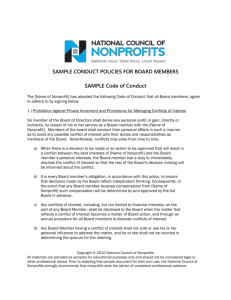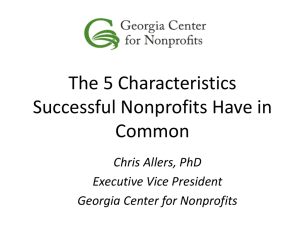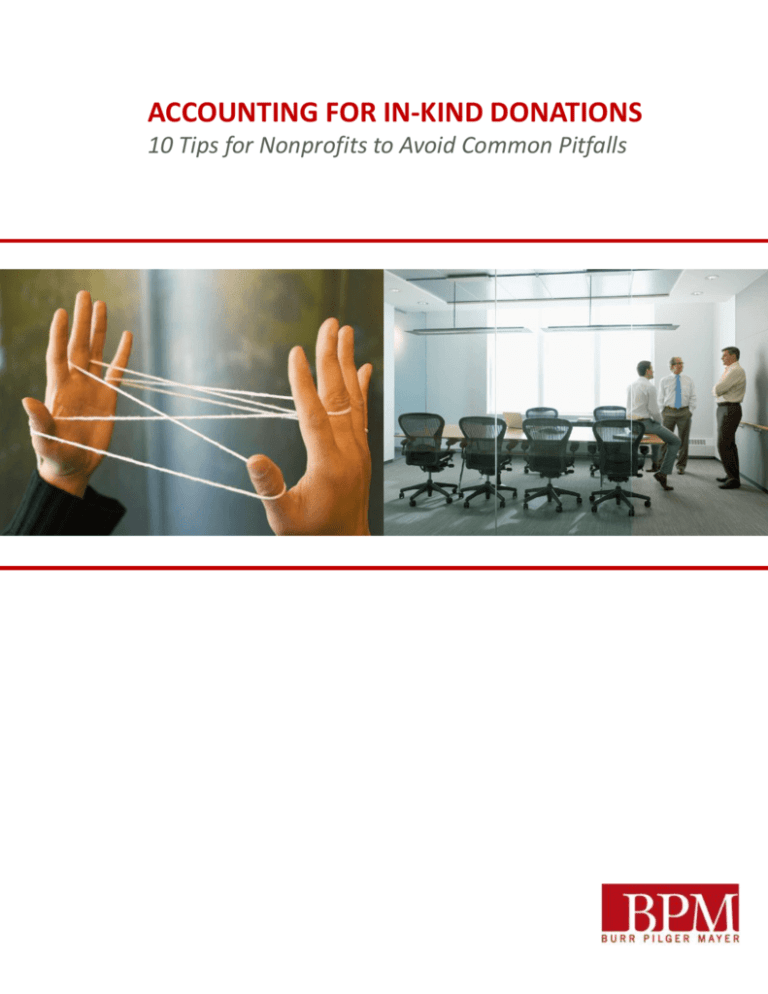
ACCOUNTING FOR IN-KIND DONATIONS
10 Tips for Nonprofits to Avoid Common Pitfalls
Introduction
Almost all nonprofit organizations receive some form of in-kind donation,
whether it is a noncash contribution or a contributed service. The types of
in-kind donations are endless and include gifts of tangible or intangible
assets, such as food, supplies, clothing, medicine, trademarks, leased
space, investment securities, vehicles, and advertising. They can also
include services received by lawyers, accountants, doctors, architects,
computer programmers, contractors, affiliated organizations and other
volunteers.
The various types of in-kind donations received require careful analysis and
consideration for how a nonprofit records these items in accordance with
accounting principles generally accepted in the United States (U.S. GAAP).
The following 10 tips will help you avoid some common pitfalls related to
in-kind donations.
NONPROFIT CLIENTS
2
“Nonprofits should record the entire
fair value of the contributed use
and not take into account whether
they could otherwise afford the
asset being used.”
1. Contributed Use of Facilities, Utilities, and Other Long-Lived
Assets
Nonprofits often receive free or discounted use of buildings, telephone or electric
utilities, or other long-lived assets from the legal owner of the property. The value of
the benefits received, in excess of any amounts paid, should be measured at fair value
and the entire contribution should be recorded as revenue in the period the
contribution is received or pledged. The amount recognized as a contribution should not
exceed the fair value of the long-lived asset at the time unconditional promise is made.
The resulting expense should be recognized during the period of use. A common
consideration when estimating the fair value of the contributed use is whether the
nonprofit would otherwise be willing to pay the market price for the same asset if its
use was not contributed. Nonprofits should record the entire fair value of the
contributed use and not take into account whether they could otherwise afford the
asset being used.
The free or discounted use of long-lived assets may often be long-term in nature. If so,
a temporarily restricted contribution receivable should be recognized as an asset for the
value not yet used up. The pledge would initially be measured at fair value on the date
of the contribution and then amortized to expense in the subsequent periods the assets
are used. For clarity, the contribution receivable may be described in the financial
statements based on the item whose use is being contributed, such as “Contributed Use
of Building.”
If the donor has also specified the purpose for which the facilities or other long-lived
assets are to be used, restricted net assets will be released once both the purpose has
been met and the time has elapsed. Recording a pledge receivable for the use of longlived assets is often a large asset addition. If it is not properly identified early, you could
end up with a significant accounting adjustment to your beginning net assets.
3
Contributed Use of Facilities, Utilities, and Other Long-Lived
Assets, continued
Example: A city constructs a performing arts center and leases it to a local
nonprofit theater company on January 1, 2014 at $10,000 a year for 20 years,
and does not specify any purpose restrictions. Also assume the lease does not
meet the criteria for a capital lease. The performing arts center would normally
be rented out for $100,000 a year, based on an analysis of comparable rentals.
The total contribution of $1,800,000 ($90,000 discounted annual rent X 20 years)
is recorded at an estimated fair value of $1,200,000, based on present value
techniques. The following initial entry would be recorded on January 1, 2014:
DR.
Promised Use of Performing Arts Center
CR.
$1,800,000
Unamortized Discount on Promised Use
$ 600,000
Temporarily Restricted Contribution Income
$1,200,000
At December 31, 2014, the balance of the unamortized discount on the promised
use of the performing arts center is now $580,000. The following entries would
be recorded at December 31, 2014 related to the promised use of the performing
arts center:
DR.
Rent Expense
$90,000
Promised Use of Performing Arts Center
Net Assets Released from Restriction –
Temporarily Restricted
$90,000
$90,000
Net Assets Released from Restriction –
Unrestricted
Unamortized Discount on Promised Use
Temporarily Restricted Contribution Income
CR.
$90,000
$20,000
$20,000
ASSETS
4
2. Gifts of Long-Lived Assets
Donors may also wish to make an outright gift of a long-lived asset where the nonprofit
retains title, such as real estate, vehicles, equipment, works of art, etc. Similar to the
contributed use of facilities or other noncash contributions, the gift would be recognized
at the asset’s fair value. Note that the accounting for works of art and other items to
be held for display in a nonprofit’s permanent collection (i.e. museums, libraries, zoos,
aquariums, historical societies, etc.) is covered by specific guidance from the Financial
Accounting Standards Board (FASB) and is not covered by this topic.
An unrestricted contribution and asset are initially recorded, unless donor-imposed
restrictions stipulate the purpose and/or use of the asset or if the asset has not yet been
placed into service. If the donor stipulates a time period the asset should be used, then
net assets will be released from restrictions over the time period stipulated by the
donor. However, if the donor does not specify a time period that the asset must be
used then the asset then temporarily restricted net assets are released once the asset is
placed in service.
Example: A school receives a donation of new artificial turf at the end of the
year for its football field from a local company. The fair value of the artificial
turf, based on an analysis of the company’s list price and quotes from other
competitors, is $400,000. The school initially records the following entry:
DR.
Construction in Progress
CR.
$400,000
Temporarily Restricted Contribution Income
$400,000
The new artificial turf is installed and placed into service 6 months later. The
donor did not specify the time period the artificial turf should be used, and
therefore the restricted net assets are released upon the asset being placed into
service. The useful life is estimated to be 10 years. The following entries would
be recorded the following year after the contribution:
DR.
Property and Equipment
$400,000
Construction in Progress
Net Assets Released from Restriction –
Temporarily Restricted
$400,000
$400,000
Net Assets Released from Restriction –
Unrestricted
Depreciation Expense
Accumulated Depreciation
CR.
$400,000
$20,000
$20,000
5
“ As a result, the FASB allows nonprofits
the option of adopting a policy of implying
a time restriction on the donated asset
that expires over its useful life.”
Gifts of Long-Lived Assets, continued
The example above results in a large increase in unrestricted net assets in the year the
asset is placed into service, while recognizing a decrease in unrestricted net assets over
time as the asset is being depreciated over its useful life. This helps to boost up total
unrestricted net assets on the statement of financial position, but creates a mismatch
between revenues and expenses on the statement of activities. As a result, the FASB
allows nonprofits the option of adopting a policy of implying a time restriction on the
donated asset that expires over its useful life. If elected, this policy must be broadly and
consistently applied from year to year both to gifts of long-lived assets and cash or other
assets restricted to the purchase of long-lived assets (e.g. capital campaign proceeds).
Example: Using the same example as above, assume the school only received a
contribution of half of the artificial turf needed for the football field and they
had to raise funds for the other half. The $200,000 needed to purchase the
remaining artificial turf was pledged by a donor in the same year the artificial
turf was contributed. The pledge will be paid the following year. The school
would initially record the following entry:
DR.
Construction in Progress
$200,000
Contributions Receivable – Temporarily Restricted
$200,000
Temporarily Restricted Contribution Income
CR.
$400,000
The artificial turf is completed and placed in service 6 months later and the
donor pledge is also paid. The following entries would be recorded the
following year after the contribution:
DR.
Property and Equipment
CR.
$400,000
Construction in Progress
$200,000
Contributions Receivable – Temporarily Restricted
$200,000
Net Assets Released from Restriction –
Temporarily Restricted
$20,000
Net Assets Released from Restriction –
Unrestricted
Depreciation Expense
Accumulated Depreciation
$20,000
$20,000
$20,000
6
3. Bargain Purchases
Nonprofits often receive significant discounts on purchases they make. Some of these
transactions may be partly an exchange transaction and partly a contribution, which
could be a bargain purchase. Bargain purchases result in an inherent contribution,
which is a voluntary transfer of assets in exchange for no consideration, or less
consideration than the value received. Evaluating a bargain purchase can be difficult,
but once identified a contribution should be recorded.
Example: A local school begins a campaign to construct its new science building
and hires a general contractor that only charges 60% of normal rates to
construct the building. If the general contractor was hired through a
competitive bidding process and the discounted price is a market price for
nonprofits, then there is likely no bargain purchase and it is entirely an exchange
transaction. However, if the general contractor normally charges 80% of normal
rates for nonprofits and provides an additional discount as part of its community
outreach or commitment to the school, then it would be a bargain purchase and
recorded as a contribution and the amount would be capitalized to the cost of
the building.
4. Donated Inventory
Public radio stations, thrift shops, organizations with vehicle donation programs, or
nonprofits that have auctions at special events and galas are just a few types of
nonprofits that regularly receive donated goods to be sold. When a nonprofit receives
donated goods that it plans to subsequently sell, it should record the donated goods at
their fair value on the date of the gift as a contribution and inventory. Thrift shops in
particular may find it challenging to value new donated inventory, because so much of
what is donated is not saleable and is often discarded or sold in bulk to specialized
dealers. As a matter of practice, these organizations may often use the value of
proceeds received in the subsequent month to record the prior month’s inventory and
perform a physical count at the end of the year.
If the goods are sold for more than the initial recorded donation, an additional
contribution is recognized for the difference between the sale price and the original
contribution. If the sale price is less than the original contribution, then a reduction in
contributions is recognized. Thrift shops will often record the initial gift as a
contribution and the subsequent sale of goods as revenues and cost of sales.
Example: A public radio station has a vehicle donation program. Listeners can
donate used vehicles that will be sold by the public radio station for cash
proceeds. At the end of the year, the public radio station has an inventory of 30
cars worth approximately $50,000. The public radio station should record a
contribution and inventory of $50,000 to reflect the proper year-end balance.
The 30 cars are subsequently sold for $40,000. The $40,000 of cash received will
be offset by a reduction in inventory of $50,000 and a reduction of contribution
income of $10,000.
7
“Nonprofits that receive donated
securities should record a contribution at
the fair value of the securities on the
date received or pledged if a nonprofit
receives verifiable documentation…”
5. Donated Securities
Donated securities are an effective way for donors to give to nonprofits that fits into
their overall personal tax planning. Nonprofits that receive donated securities should
record a contribution at the fair value of the securities on the date received, or pledged
if a nonprofit receives verifiable documentation of committing certain securities before
they are actually received. Any difference between the value of the pledge and the
value of the securities subsequently received would be recorded as an additional
contribution or a reduction of contributions.
Most nonprofits have a policy of selling donated securities shortly after receipt, often
within a few days. Nonprofits should be keep in mind that any difference between the
proceeds received from the sale of donated securities and the fair value on the date the
donated securities were received should be recognized as a realized gain or loss. The
costs to sell the securities should also be separately recognized as investment fees
expense.
Example: A community foundation receives a letter on January 2, 2014 from a
donor stating that he plans to contribute 200 shares of Apple Inc. The
community foundation calculates the average of the high and low share prices
on January 2, 2014 and determines the share price to be $550. The community
foundation records a contribution and pledge receivable of $110,000 ($550
share price X 200 shares) in January 2014. On April 14, 2014, the community
foundation receives the 200 shares in its brokerage account at a value of
$104,000. The shares are sold on April 24, 2014 for $113,000 with a brokerage
fee of $1,000. The community foundation would record the following entry in
April 2014:
DR.
Cash
$112,000
Contribution Income
6,000
Investment Fees
1,000
CR.
Pledges Receivable
$110,000
Realized Gains
9,000
8
6. Agency Transactions
Nonprofits may receive in-kind donations of tangible assets as the ultimate beneficiary.
In other cases, the nonprofit may initially receive the in-kind donation, but then
transfers it to another nonprofit beneficiary. If the nonprofit is merely an intermediary
that does not have discretion over who receives the donation, then it should be
accounted for as a pass-through agency transaction and not recorded as a contribution.
However, if the nonprofit bears the risks and rewards of ownership of the donated
goods and has the discretion with regard to the ultimate nonprofit beneficiary, then a
contribution should be recorded.
Example: An international aid nonprofit receives donated drugs from
pharmaceutical company partners and distributes them to local hospitals in
Haiti. The nonprofit normally has discretion over how it distributes the donated
drugs, except one of the pharmaceutical companies wants the aid to go to a
particular town and has named the local hospital to receive the drugs. The
nonprofit would record a contribution and program services expense for the
majority of its donated drugs. However, the donation where a specified hospital
had been named would initially be recorded as an asset and a liability when
received until passed on to the hospital.
7. Contributed Services
The majority of nonprofits receive some form of volunteer time, whether it is for direct
service in its programs, consultants, vendors, or board involvement. The value of
contributed services must be recognized if the service either (1) creates or enhances
assets that are not financial in nature (e.g. buildings, materials, supplies, etc.), or (2)
requires specialized skills, are provided by individuals with those skills, and would
typically need to be purchased if the services had not been donated. Common types of
contributed services include architects, teachers, lawyers, accountants, bankers,
investment advisors, doctors, construction services and property maintenance. The
following examples provide some considerations when evaluating the criteria for
recognizing a contributed service.
Services Creating or Enhancing a Nonfinancial Asset
Example: A local women’s shelter is building a new house for its families and
receives volunteer time from an architect that provides pro bono services. A
community group also helps to paint the house. Since both the architect and
painting services are enhancing the building, all services would be recognized at
their fair value, even though the painting services do not require a specialized
skill.
VOLUNTEER
9
Contributed Services, continued
Specialized Skills
Example: A counseling center for veterans has a team of licensed psychologists
that provide free counseling to veterans returning from combat in a country at
war. The licensed psychologists have been able to scale the program by
developing an in-depth one month training program for community volunteers
to assist in providing counseling services. The counseling center would only
recognize the fair value of the licensed psychologists volunteer time, because
they have a specialized skill. Common indicators of specialized skills include
maintaining a particular license or certification, or working with technical tools
or artistic talent at a proficiency greater than the general public. Although the
community volunteers have received intensive specialized training, they do not
possess the required licenses or certifications to qualify as individuals with
specialized skills.
Individuals Possessing the Specialized Skills
Example: A local Red Cross has volunteers that assist in recovery efforts after a
natural disaster. They may participate in extensive medical training beforehand,
but if they are not licensed doctors or registered nurses, then they do not possess
the specialized skills.
The Need to Purchase Services
Example: The Symphony is throwing its annual gala, which will feature a worldrenowned violinist that would normally cost $40,000 for a performance. The
violinist has a special affinity to the Symphony and donates her performance. If
the Symphony determines that it would not normally pay $40,000 for a gala
performer and would probably forego the performance if it were not donated,
then the Symphony would likely not be required to record a contribution.
Another area that is often overlooked is when a nonprofit receives contributed services
from one of its board members. Since board members are expected to utilize their
specialized skills in serving the nonprofit, their services may often not be recognized as a
contribution.
Example: A nonprofit board member is a lawyer by trade and provides pro bono
legal services through her law firm. The law firm advises on board governance,
review of contracts, and other general business matters. Since the board
member is expected to use her specialized skills in her capacity as a board
member, a contribution would not be recognized. However, if the nonprofit was
facing litigation and the law firm was representing the nonprofit on a pro bono
basis, their services would likely be recognized as a contribution. The value of
legal representation is outside of the expectation of a board member’s
responsibilities and the nonprofit would otherwise have to pay another lawyer
for these services.
10
“Some nonprofits would record a
contribution for these services and
others would not.”
8. Contributed Personnel Services from Affiliates
Nonprofits may be affiliated with other nonprofit or for-profit organizations that provide
their staff time, free of charge or below market, to assist with the nonprofit’s activities.
The common types of nonprofits with these affiliate relationships may include, but are
not limited to, national or international organizations with local chapters, religious
schools, corporate or supporting foundations, and certain healthcare entities. Until
recently, the accounting guidance was not clear on how to treat these contributed
services, because the criteria for recognizing contributed services, as described in item
6, did not fit this circumstance. Some nonprofits would record a contribution for these
services and others would not. This resulted in the FASB issuing Accounting Standards
Update (ASU) 2013-06, Not-for-Profit Entities: Services Received form Personnel of an
Affiliate, which requires nonprofits to record the value of personnel services of an
affiliate at either (1) the cost recognized by the affiliate or (2) the fair value of that
service. This new standard is effective for fiscal years beginning after June 15, 2014, but
early adoption is permitted.
Example: A local professional sports team provides staff, free of charge, to its
affiliated nonprofit charity for the administration of its programs. The nonprofit
estimates the personnel time involved as 50% of two marketing staff, 80% of one
accounting staff, and 20% of one IT support staff. This costs the professional
sports team $200,000 for salaries and benefits. The team would record an inkind donation and a corresponding expense for salaries and benefits of
$200,000.
RELATIONSHIPS
11
“Identifying the principal
market should be based from
the perspective of the
nonprofit…”
9. Valuation Considerations
In-kind donations that can be used or sold must be measured at fair value and follow
the established framework under U.S. GAAP, which is based on the concept of “exit
price”. Valuation of in-kind donations is clearly the most challenging part of recognizing
these gifts, because it may be difficult to determine the “highest and best use” and an
“active market” for the in-kind donation. A Level 1 input in the fair value hierarchy,
which is a “quoted price in an active market” for an identical asset or liability, just does
not exist for many of the items donated to a nonprofit. However, public information is
often available for identical or similar assets in inactive markets, which are considered
Level 2 inputs. Some useful valuation resources include:
• General Goods
o eBay and other online auction websites
o Valuation guides published by Goodwill
Industries International or The
Salvation Army
o ItsDeductible software from TurboTax
• Food
o Annual study by Feeding America that calculates the cost per pound of food
• Real Estate
o Zillow, Trulia, Redfin and other residential real estate websites
o LoopNet for commercial real estate
• Pharmaceuticals
o Red Book:
Pharmacy’s Fundamental Reference
• Vehicles
o Kelley Blue Book,
Edmunds.com, and other similar websites
Another key determination with valuing in-kind donations is to identify the “principle
market”, which is the market with the greatest volume and level of activity for the asset
or liability. Identifying the principle market should be based on the perspective of the
nonprofit, since different organizations have different purposes and activities.
Example: An international aid nonprofit that receives donations of a
pharmaceutical nature will not likely look to retail pharmacies as its principal
market, since it does not have the licenses or comply with their regulations.
However, a community health clinic with a pharmacy may look to retail
pharmacies as a principle market.
12
Valuation Considerations, continued
Nonprofits should not necessarily only look to the recipients of their services when
determining the principal market. Just because a nonprofit provides its in-kind
donations free of charge or for a discounted price to disadvantaged communities does
not mean the donations it receives have a lower value.
Example: A homeless shelter with a free clothing program and a thrift shop that
sells clothing may both look to thrift shops as their principal market, even
though one provides clothes free of charge and the other sells them for a profit.
Nonprofits also receive in-kind donations with restrictions on the use of donated assets.
It is important to distinguish between legal restrictions and donor restrictions placed on
the nonprofit. Donor restrictions should not have an effect on the valuation of an inkind donation, like when evaluating the market participants or principal market.
Example: A famous athlete donates some valuable sports memorabilia to his
alma mater for display in the gymnasium, but with the stipulation that the items
cannot be sold. The donor’s restriction limiting the sale of the sports
memorabilia does not mean a discount should be taken when calculating the
fair value.
However, legal restrictions may affect the determination of the principal market, since
market participants would factor those restrictions when valuing the asset in a sale.
Example: A public land trust receives a donation of land from a donor that has a
conservation easement on it, limiting the legal use of the land. When the public
land trust uses an appraiser to determine the value of the donation, the
appraiser will likely arrive at a lower value when compared to other comparable
land sales that do not have similar legal restrictions.
If a nonprofit receives an in-kind donation in bulk quantity, it should take that into
account when determining fair value. Accounting standards state that the quality and
quantity of gifts should be considered for valuation purposes.
Example: A food pantry receives a bulk shipment of produce from a grocery
store. The food pantry should evaluate what sort of wholesale discounts are
appropriate for this bulk quantity. Also, the quality of the produce is not as fresh
as when it is sold in the store, which may lead to a further discount.
VALUE
13
“Each type of donation, whether it
is a fixed asset, inventory, supplies
or services, has its own set of
accounting nuances that must be
considered and addressed.”
10. Make a Plan
One of the most essential things a nonprofit can do in advance of accepting any in-kind
gift is to create a gift-acceptance policy that outlines the protocol for accepting various
types of gifts. This can become especially important when presented with an unusual
gift where the nonprofit needs to consider potential contingent liabilities associated
with accepting the asset or if it aligns with the mission of the nonprofit and the public
perception of receiving the gift.
Example: An environmental organization is notified by a coal mining company
that it wants to donate land from a former coal mine to the organization. The
environmental organization would want to evaluate the potential liabilities and
associated risks before accepting the gift. There may also be a negative
perception with receiving a large gift from this particular company and
alignment with the nonprofit’s mission. An effective gift acceptance policy
provides the mechanism for evaluating and possibly rejecting this potential gift.
The policy should include a checklist of considerations for determining the usefulness,
appropriateness, and programmatic impact of a potential gift. Each type of donation,
whether it is a fixed asset, inventory, supplies or services, has its own set of accounting
nuances that must be considered and addressed. As a result, the best plan of action is to
create a predetermined set of standards and policies that will help the organization
uniformly address each donation.
CHECKLIST
14
Additional Resources
Many good resources are publicly available to assist nonprofits with valuation
considerations and establishing gift-in-kind policies as well as best practices. Some of
these useful resources include:
• Accord Network Interagency Gift-in-Kind Standards
(http://www.accordnetwork.org/wp-content/uploads/2013/04/gik-standards2009.pdf)
• InterAction PVO Standards
(http://www.interaction.org/sites/default/files/PVO%20Standards%20%20%20
March%202%2C%202013.pdf)
• The Partnership for Quality Medical Donations (PQMD) Guidelines for Quality
Medical Product Donations
(http://www.pqmd.org/assets/pqmd%20standard%20jan%202014.pdf)
• World Health Organization Guidelines for Medicine Donations
(http://whqlibdoc.who.int/publications/2011/9789241501989_eng.pdf?ua=1)
• The Sphere Project: Humanitarian Charter and Minimum Standards in
Humanitarian Response (http://www.sphereproject.org/resources/downloadpublications/?search=1&keywords=&language=English&category=22)
• IRS Publication 561, Determining the Value of Donated Property
(http://www.irs.gov/pub/irs-pdf/p561.pdf)
15
About BPM and the Author
Burr Pilger Mayer, Inc. (BPM) is one of the largest California based accounting and
business consulting firms. Founded in 1986 and headquartered in San Francisco, BPM
has six locations in the Bay Area including San Jose, Palo Alto, Walnut Creek, St.
Helena, and Santa Rosa. We are committed to providing you with the tools and
resources to help you succeed. The firm is a valuable resource for accounting, tax
(corporate, international, high net worth individuals), business valuation, succession
planning, nonprofit issues, and much more. Our staff of experts constitutes more than
350 people who are united by a culture of trust, dependability and a commitment to
understanding the needs of our clients.
For more information, please visit www.bpmcpa.com
Daniel Figueredo, CPA
Shareholder, Nonprofit Industry Practice Leader
DFigueredo@bpmcpa.com
415-288-6284
© May 2014 BPM Inc. All Rights Reserved.
This publication contains information in summary form and is intended for general guidance only.
It is not intended to be a substitute for detailed research or the exercise of professional judgment.
Neither BPM nor any other member of the BPM firm can accept any responsibility for loss brought
to any person acting or refraining from action as a result of any material in this publication. On any
specific matter, reference should be made to the appropriate advisor.
16


